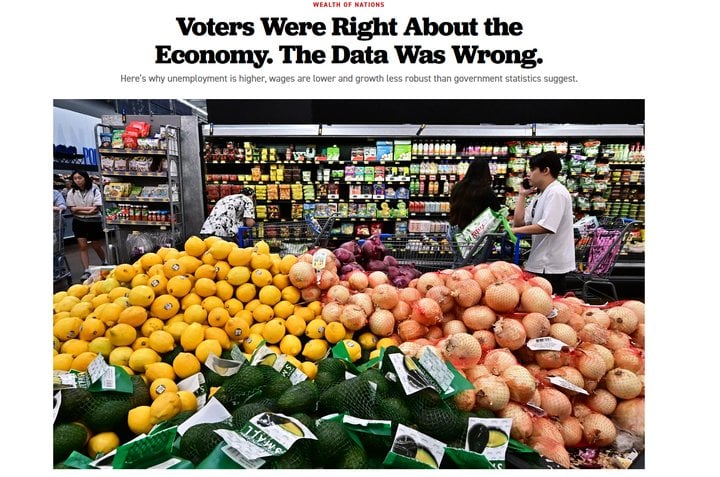This page is a permanent link to the reply below and its nested replies. See all post replies »
SunshineGirl · 36-40, F
Governments use a commonly agreed set of statistics to measure economic performance and to allow comparisons with other economies. So long as the methodology is agreed in advance, compiled independently, and not amended without good reason, this is wholly legitimate. Beyond that, governments like to put a positive spin on their achievements, while large numbers will feel bad for falling short of the "average". Nothin unusual.
I cannot imagine that Trump will be deviating too far from these standards when he comes to measure his own government's performance. But beware any statistics quoted by DOGE.
I cannot imagine that Trump will be deviating too far from these standards when he comes to measure his own government's performance. But beware any statistics quoted by DOGE.
SumKindaMunster · 51-55, M
@SunshineGirl The point of the article is to call out these set of statistics as being misleading and no longer capturing data that reflects the experience of all Americans.
Here's one that I knew about, the Unemployment rate. This rate is NOT reflective of most people's reality for the following reasons:
Here's one that I knew about, the Unemployment rate. This rate is NOT reflective of most people's reality for the following reasons:
Take, as a particularly egregious example, what is perhaps the most widely reported economic indicator: unemployment. Known to experts as the U-3, the number misleads in several ways. First, it counts as employed the millions of people who are unwillingly under-employed — that is, people who, for example, work only a few hours each week while searching for a full-time job. Second, it does not take into account many Americans who have been so discouraged that they are no longer trying to get a job. Finally, the prevailing statistic does not account for the meagerness of any individual’s income. Thus you could be homeless on the streets, making an intermittent income and functionally incapable of keeping your family fed, and the government would still count you as “employed.”
I don’t believe those who went into this past election taking pride in the unemployment numbers understood that the near-record low unemployment figures — the figure was a mere 4.2 percent in November — counted homeless people doing occasional work as “employed.” But the implications are powerful. If you filter the statistic to include as unemployed people who can’t find anything but part-time work or who make a poverty wage (roughly $25,000), the percentage is actually 23.7 percent. In other words, nearly one of every four workers is functionally unemployed in America today — hardly something to celebrate.
I don’t believe those who went into this past election taking pride in the unemployment numbers understood that the near-record low unemployment figures — the figure was a mere 4.2 percent in November — counted homeless people doing occasional work as “employed.” But the implications are powerful. If you filter the statistic to include as unemployed people who can’t find anything but part-time work or who make a poverty wage (roughly $25,000), the percentage is actually 23.7 percent. In other words, nearly one of every four workers is functionally unemployed in America today — hardly something to celebrate.
SunshineGirl · 36-40, F
@SumKindaMunster I used to work with similar statistics for the UK government. One of the main problems is that few people engage with these type of surveys anymore. There are big areas of uncertainty, especially with unemployment. As I say, so long as the stats are compiled independently and prople read them critically, that is the best we can do.
This comment is hidden.
Show Comment
ninalanyon · 61-69, T
@SumKindaMunster
The state statistics bureau here also publishes data about those who are neither working, in education, nor training (called NEETs in the UK I believe) and that is a pretty stable 18% of the working age population (defined as 20 to 66 years old).
Surely that statistic is also available in the US?
It's not the statistics that are the problem (at least not invariably) it is that politicians and media of all kinds are selective in their use of them and rely on the general public being ill-informed about (and often uninterested in) what is actually being measured.
a mere 4.2 percent
That's almost exactly the figure we have in Norway. And here it is regarded as a bit higher than it should be. But to be regarded as unemployed for this statistical purpose one must be actively looking for a jobThe state statistics bureau here also publishes data about those who are neither working, in education, nor training (called NEETs in the UK I believe) and that is a pretty stable 18% of the working age population (defined as 20 to 66 years old).
Surely that statistic is also available in the US?
It's not the statistics that are the problem (at least not invariably) it is that politicians and media of all kinds are selective in their use of them and rely on the general public being ill-informed about (and often uninterested in) what is actually being measured.
ninalanyon · 61-69, T
@ninalanyon Also, from the article:
What we uncovered shocked us. The bottom line is that, for 20 years or more, including the months prior to the election, voter perception was more reflective of reality than the incumbent statistics. Our research revealed that the data collected by the various agencies is largely accurate. Moreover, the people staffing those agencies are talented and well-intentioned. But the filters used to compute the headline statistics are flawed. As a result, they paint a much rosier picture of reality than bears out on the ground.





